Native Son: Olde Oakes
As I went stompin’ ‘round my ol’ stompin’ ground at the Fort Worth Botanic Garden, I saw many old friends. Some were still standing tall; others simply gone, like they never existed. Still others lie in pieces on the ground, like many of the dreams I had for myself back when I was gardening there. I saw a few only with my memory—a once shady path is now in full sun—but I still talk to them all.

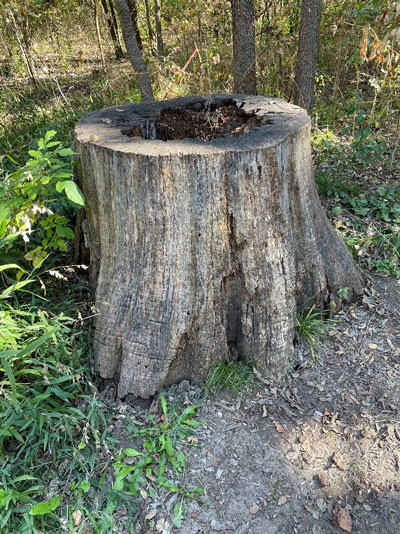
Sometimes I wonder if there are only two kinds of people in this world; those who talk to trees and those who think that we tree talkers are crazy. To those who can only look upon trees, I must seem completely insane, as I hold conversations with trees all the time. And yes, the trees do their share of talking as well, though it seems they only do so to those of us who will listen. Hmmm…maybe that’s what’s really happening…the trees choose who to talk to; they already know who will listen.

So I’m under this massive old Bur Oak, stuffing my guayabera shirt pockets full of acorns. This particular oak oversaw one of my most memorable projects at the FWBG…installing the stone rim around the edge of the pond at the foot of the Rose Ramp back about 1999. I love that this same tree oversaw the digging of that pond back in 1934. I know this because I found a few almost uncirculated coins while excavating some soil for a boulder, and all were dated 1933 and 1934. I remember being so excited about finding a direct connection to a workman who most likely laid down to rest and lost his pocket change 65 years prior. I also remember that no one else at the garden was amazed or excited by this scenario…and I was so stunned that no one else at the garden found my discovery amazing or exciting. I suppose I still am.
(For the record, I left those coins in a marked envelope in my office when I moved on, except for that magnificent 1934 buffalo nickel…which I still have and treasure. I can only hope the other coins didn’t end up in a Pepsi machine.)
(Also for the record, the coins did not talk to me.)
If I had to choose, I suppose the Bur Oak (Quercus macrocarpa) is my favorite oak. Big leaves, big acorns, big tree. I even had a favorite specimen—the monstrous specimen with a giant burl in front of the pavilion in Fort Worth’s Trinity Park. Gone now, but its non-burled twin remains.
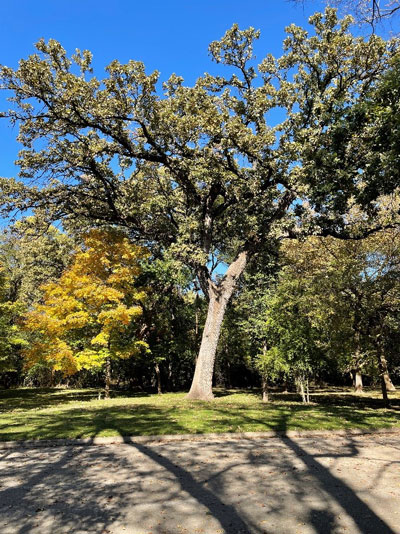
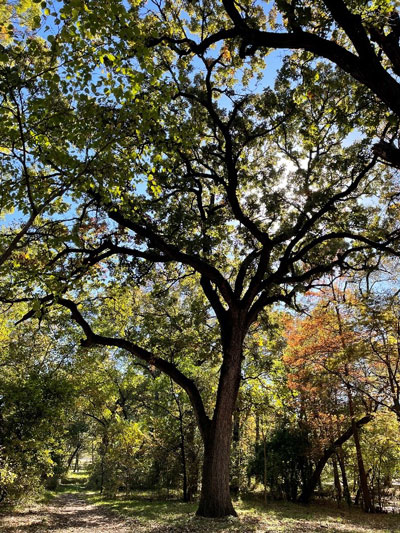
Of course, it’s pretty ridiculous to have a favorite because I haven’t seen most of the 400 to 500 species of oaks around the world. A few are familiar to us, but most are not—even the ones native to Texas! Did you know that, according to Benny Simpson, there are at least 42 species of oak native to Texas? But Benny died in 1996, shortly after I was lucky enough to meet him, and taxonomists now say the number is “more than 50.” Hybridization plays a role in that imprecise number, as does the disposition of the scientist…some are “lumpers,” some are “splitters.” Regardless, the vast majority of our native oak species are in West Texas…and most are small, scrubby species. In case there’s a grove of Bur Oaks out near Van Horn…that was a 30 year-old me who poured a bucket of acorns into a creek back then.
Of course, there are some cool tidbits about oaks…
Cork is cut from the bark of Quercus suber, the Cork Oak.
Oaks are divided into two groups; the White Oak group and the Red Oak group. The quickest distinguishing feature is that red oaks have pointed, bristle tips on their leaf lobes; white oaks have rounded lobe tips.
Barrels are only made from white oaks, as the wood structure holds water better.
The tallest oak on record – more than 200 feet tall – was the Mingo Oak in West Virginia. Measured in 1931; it died from either poisonous gas from a mine or human development immediately around the tree (or both) and was cut in 1938. The trunk was just shy of 10 feet in diameter near the bottom. In spite of internal damage on the lowest 24 feet of the trunk, foresters managed to salvage two logs from the tree…a 66-foot-long piece and a 40-foot-long chunk! Several “tree cookies” were cut and are still on display today.
I remember the huge acorn cap I saw on a Mesoamerican Oak (Q. insignis) in Costa Rica that seemed like it would have held a tennis ball!
People like to believe oaks are thousands of years old, but most are less than 200. Texas has some Post Oaks that do indeed approach 500 years of age, as does Austin’s Treaty Oak. That monstrous Goose Island Live Oak is often touted as “more than 1,000 years old.” England is famous for ancient oaks, though more than 15 million trees were toppled by “The Great Storm of 1987.”
Old oaks make me think a lot about life. In horticulture, there have certainly been some magnificent old oaks—Luther Burbank, Liberty Hyde Bailey, John Bartram…but they are all long gone now. I have personally known some old oaks that have passed—Benny Simpson, Ralph Pinkus, JC Raulston—and am grateful that I learned from them. Still, there are old oaks that live among us—Neil Sperry, Jack Stanford, Dave Creech, Barney Lipscomb, and many others—and I’m still learning from them these days. And, sure enough, all will pass, some from the storms of life, others simply from age. But, in the tradition of all old oaks, they have dropped lots of acorns of knowledge that will lead to future forests, from which will hopefully rise another generation of old oaks. And so on…and so on.
Such is Nature’s plan for this world…and I am at peace with that.


Below: A remnant from my days at the FWBG…the best question ever posed to me by a second grader made into an interpretive panel. I still love it today!
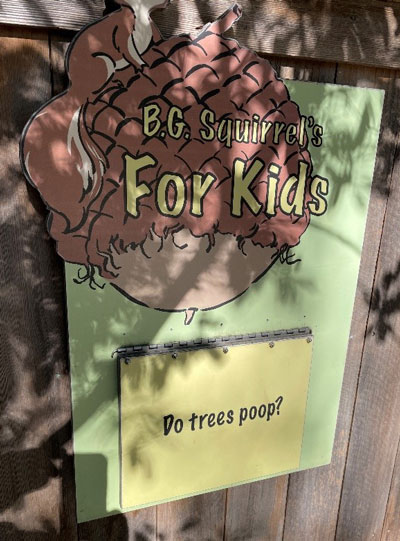
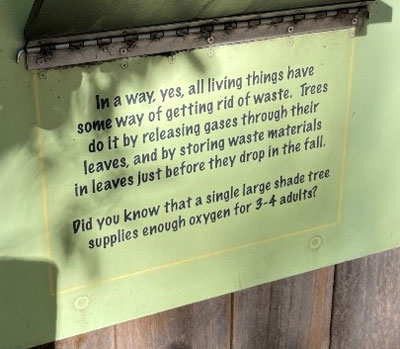
_________________________________________________________________________
Just so you know… the Longview Arboretum & Nature Center is OPEN! Hours are 10am-5pm, Wednesday through Saturday; Sunday 12 noon-5pm. Come out and see us! And bring your own brand of Zen! 903-212-2181 Longviewarboretum.org.
I need a road trip! Let me know if you’d like me to come and speak to your group sometime. I’m low maintenance, flexible, and you know I like to go just about anywhere. No city too big; no town to small. Just send me an e-mail at stevenchamblee@yahoo.com and we’ll work something out.
